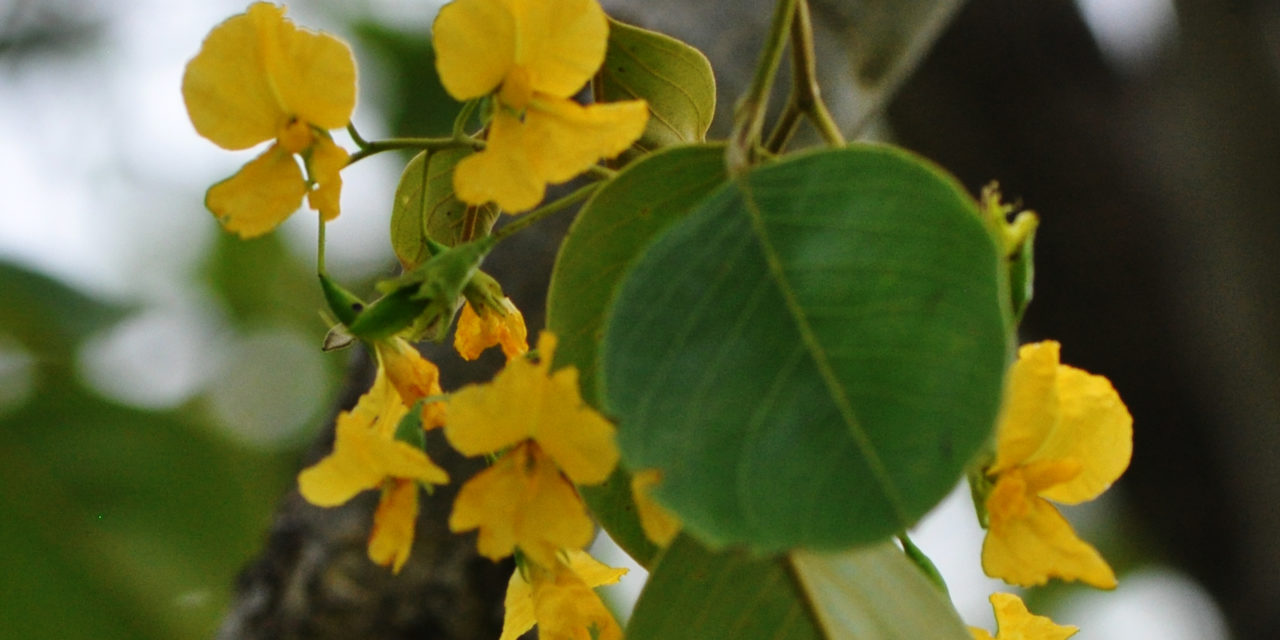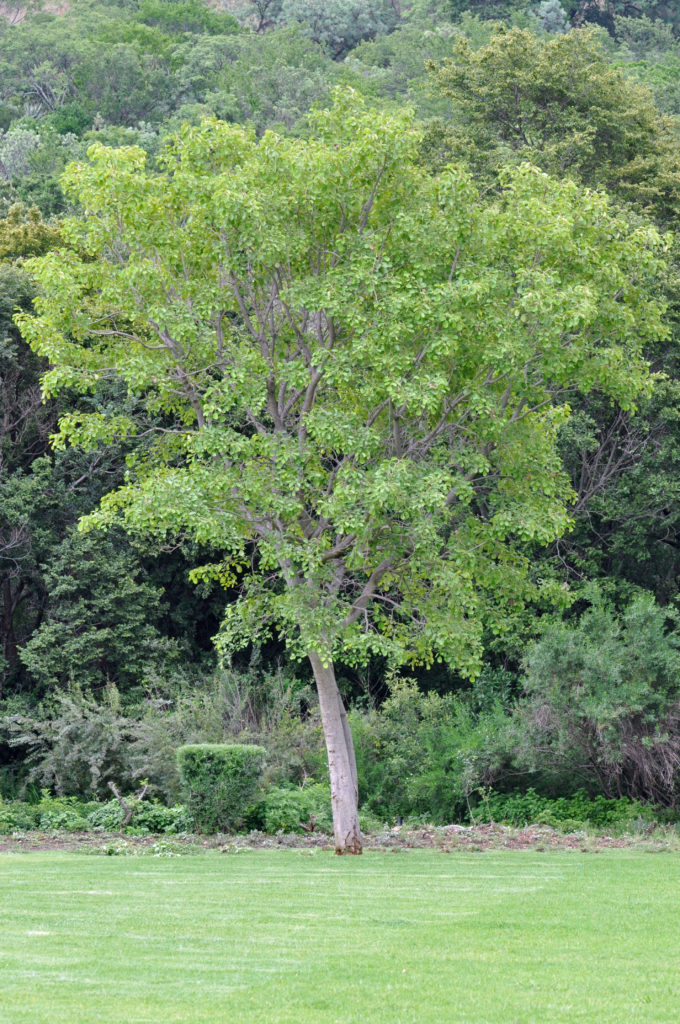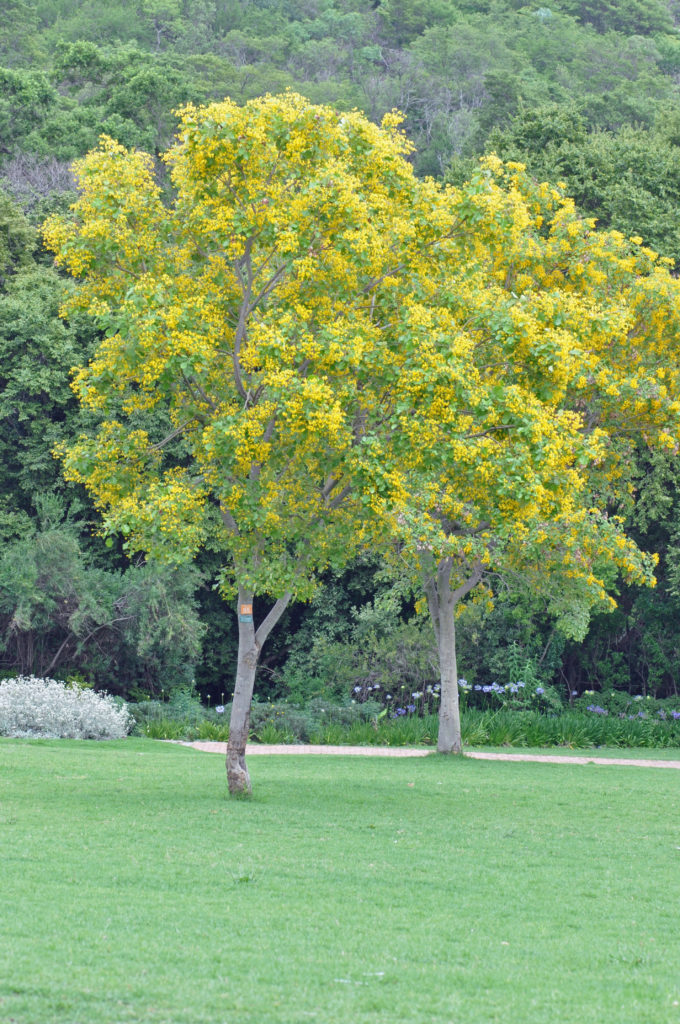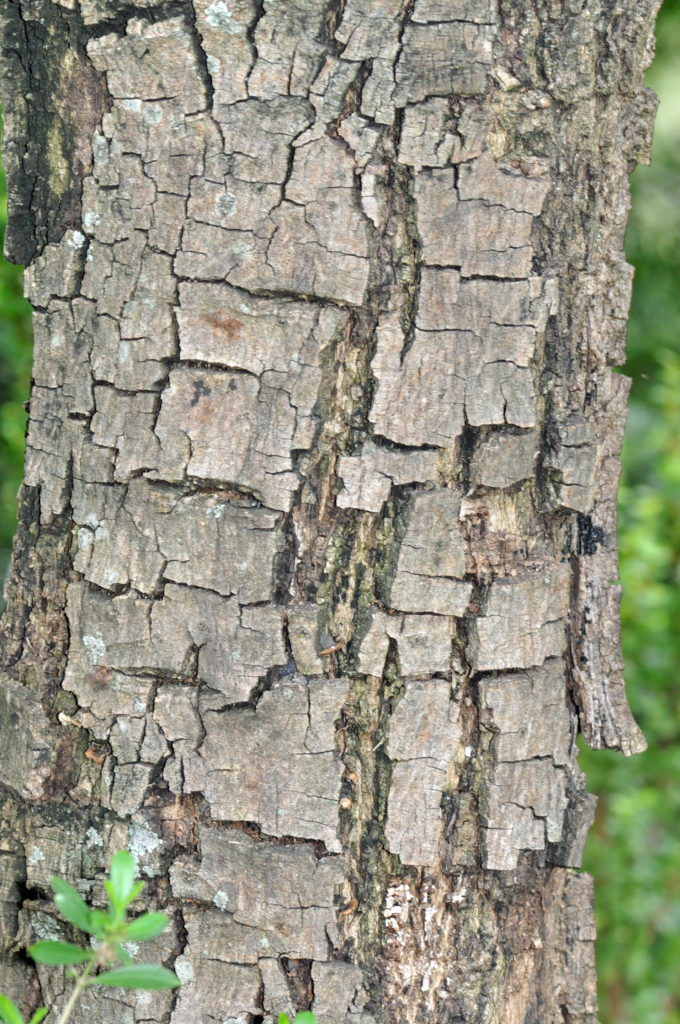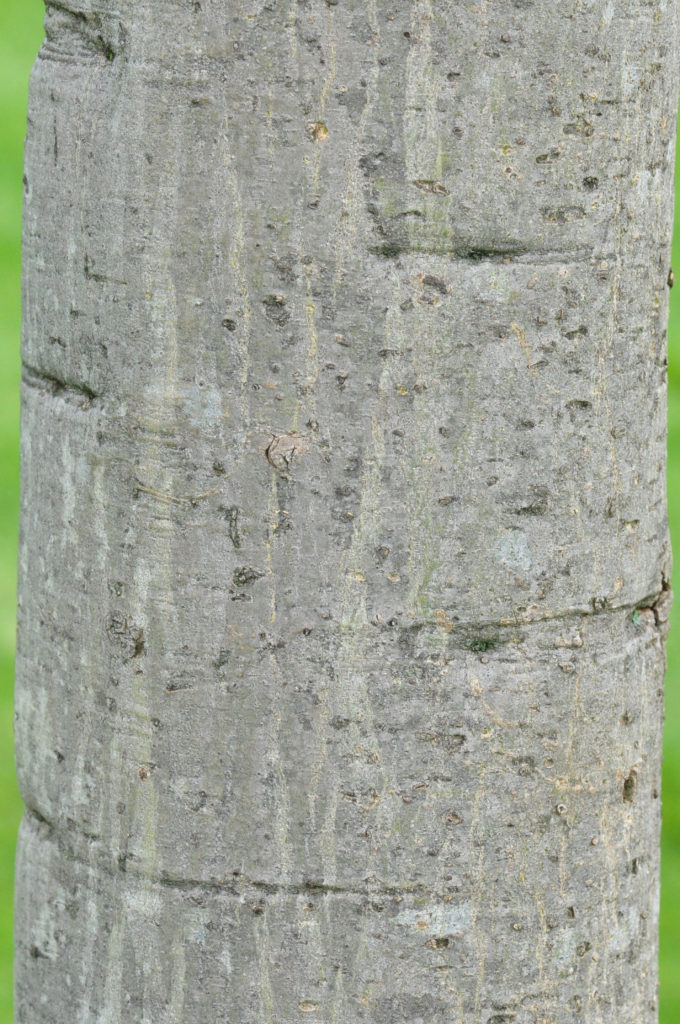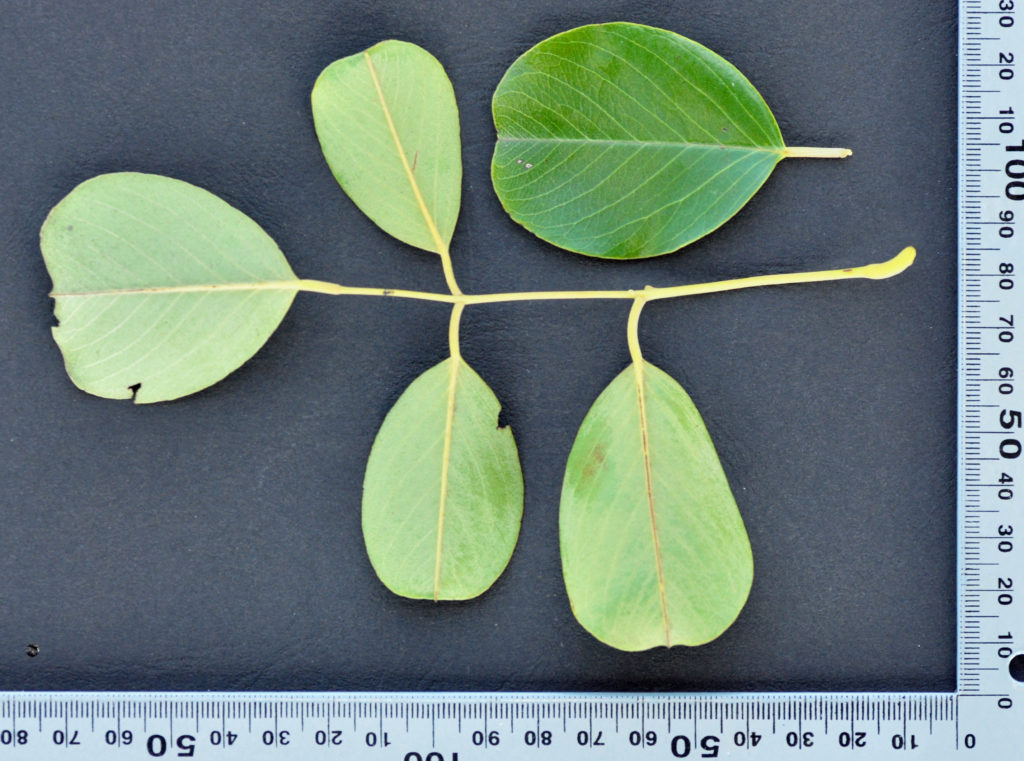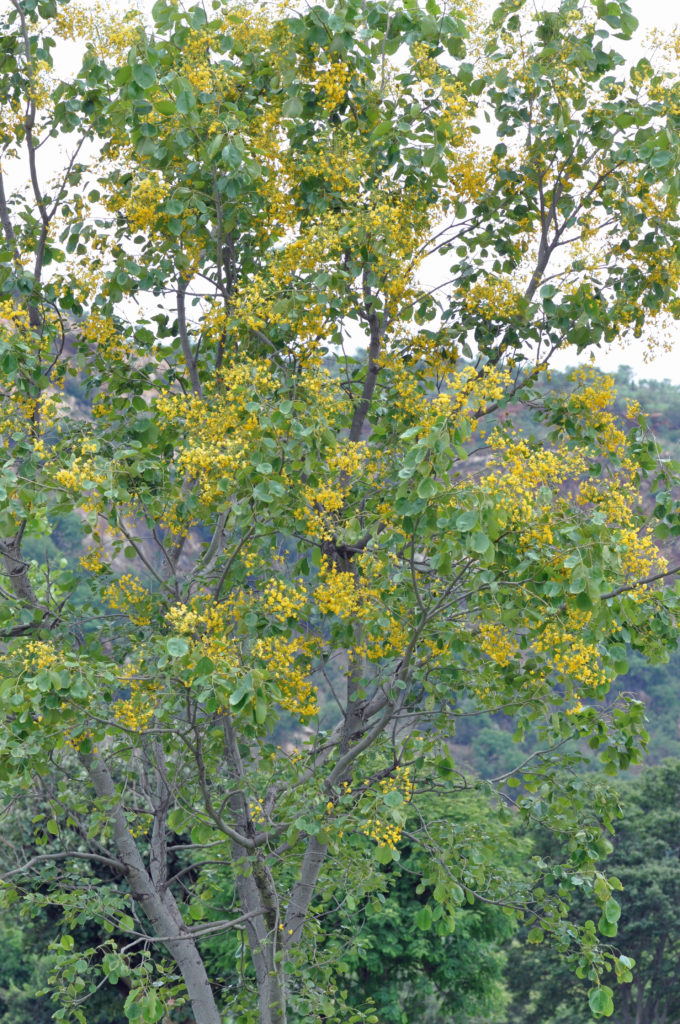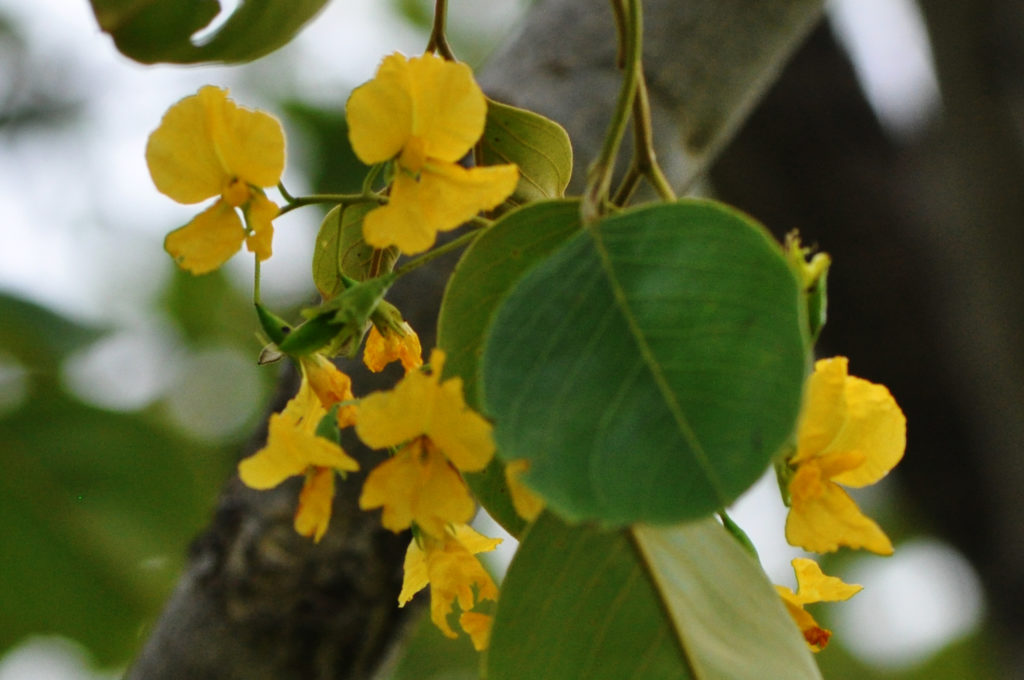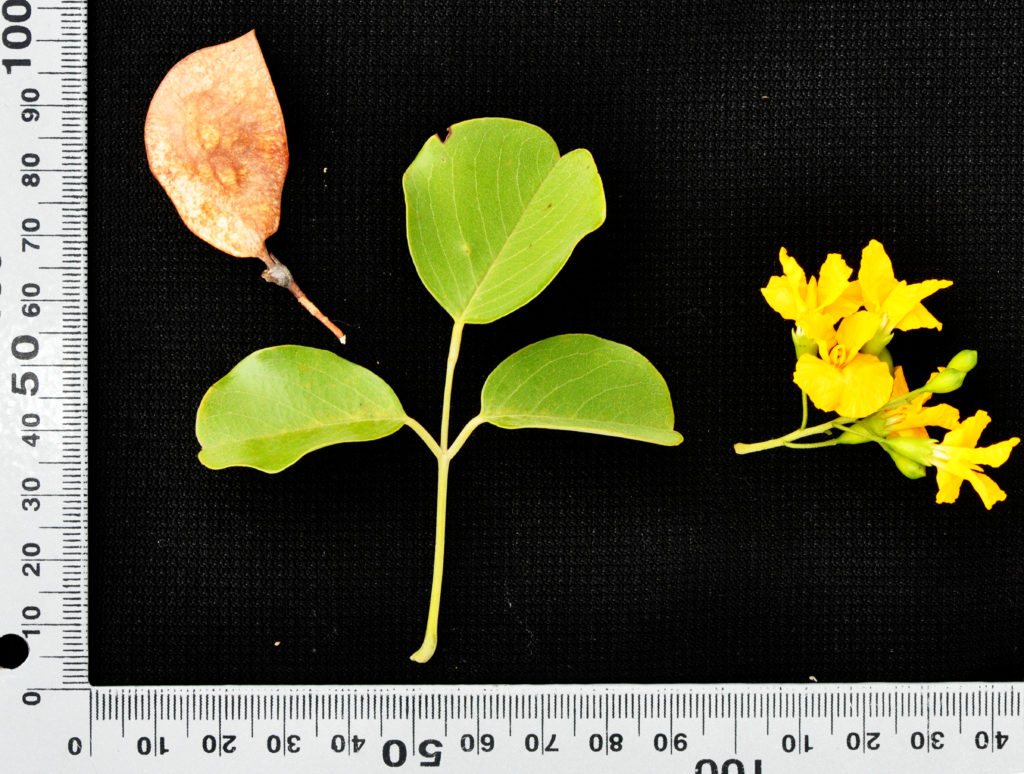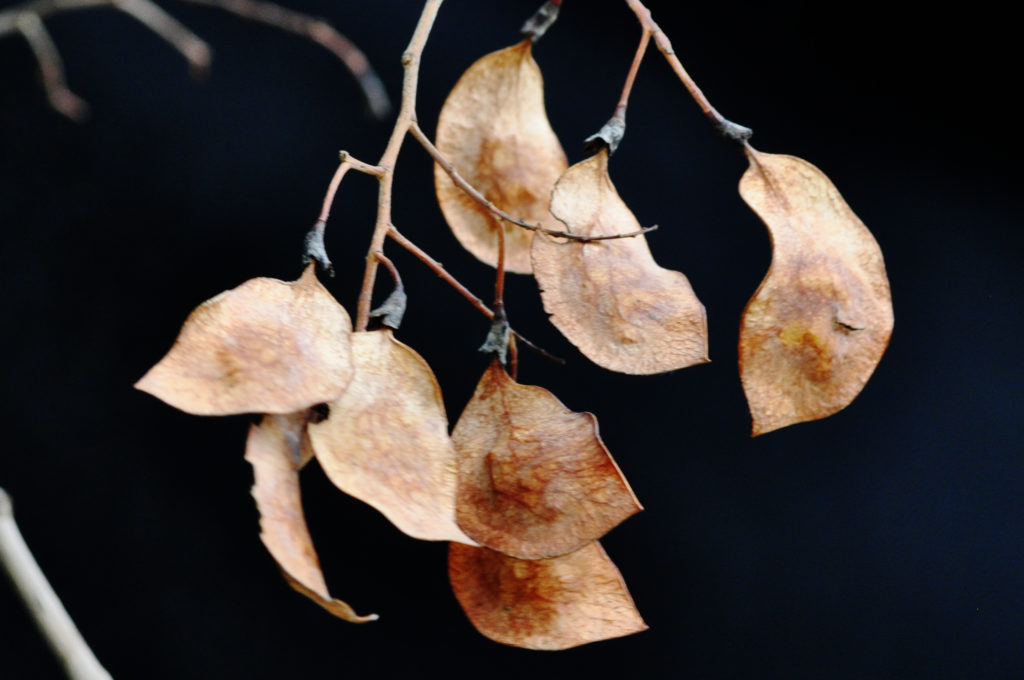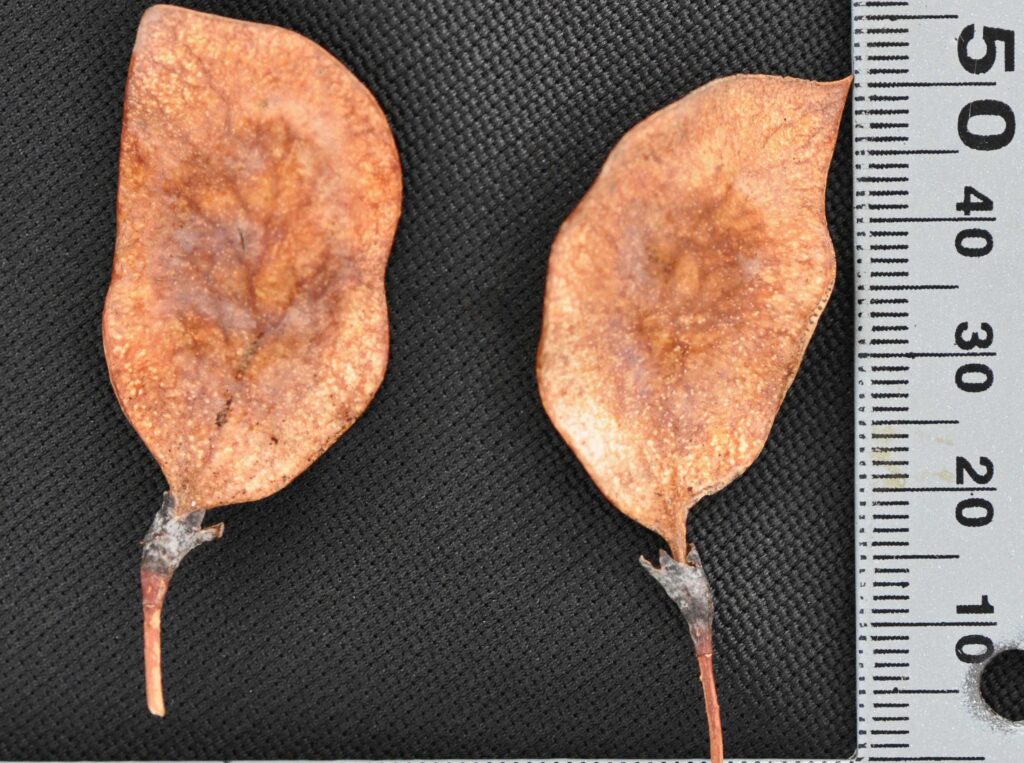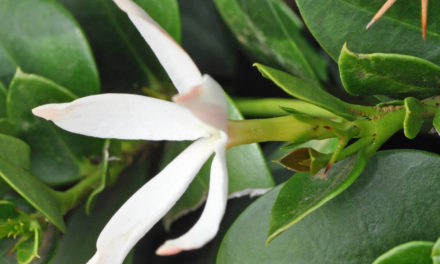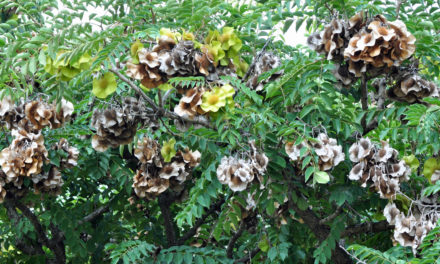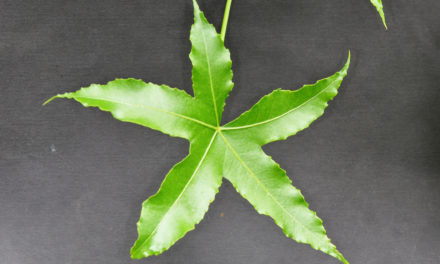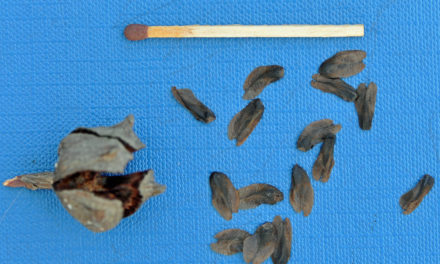General Info – summary
This multi-stemmed plant may be a single stemmed Tree up to 20m high. The imparipinnate Leaves have roundish leaflets with entire margins. Bisexual, zygomorphic, 5-merous pea-like Flowers have golden yellow petals. Within this are 10 stamens, a single pistil with a superior ovary and a small stigma. Fruit is an asymmetrical bristle lacking flat pod and usually has 1 small wind-dispersed seed.
Description
Pterocarpus rotundifolius subsp. rotundifolius
Previous Names: Dalbergia rotundifolia, Pterocarpus sericeus.
SA Tree No. 237.
Common names: (Afr) Blinkblaar, Blinkblaarboom, Dop-ertjiekiaat, Dopperkiaat, Dopperkiaathout, Kiaathout, Rondeblaarkiaat, Wildekweper. (Eng) Round-leaved Bloodwood, Round-leaved Kiaat, Round-leaved Teak. (isiZulu) Indlandlovu. (Northern Sotho) Mohwahlapa, Mokwatapa. (siSwati) Indlebe-lendlovo, Indlebezindlovu. (Tshivenda) Muathaha, Mushasha-phombwe. (Xitsonga) Miyataha, Muyataha, Ndleve-ya-ndlopfu, Nshelela.
Family: Fabaceae, or Leguminosae (Pea, bean or legume family). After the Orchidaceae and the Asteraceae, the Fabaceae is the third largest Angiosperm (flowering plants) family with 700+ genera and close to 20 000 species. Local Tree genera on this website include Acacia (Vauchellia, Senegalia), Albizia, Bauhinia, Bolusanthus, Burkea, Calpurnia, Colophospermum, Cordyla, Cyclopia, Dichrostachys, Erythrina, Erythrophleum, Faidherbia, Indigofera, Mundulea, Peltophorum, Philenoptera, Piliostigma, Schotia and Xanthocercis. The Fabaceae are recognisable by their fruit and by their pinnately compound Leaves. Leaves may also be simple – even bilobed and usually have stipules – some of which may be spinescent. Leaflets are usually entire. Flowers are bisexual and bracteate. Regular flowers usually have 4-5 sepals and the same number of petals. Irregular flowers have 4-5 sepals and 5 or less petals. Stamens have anthers that have 2 pollen sacs and there are usually at least twice the number of stamens as petals – often 10. The superior Ovary has 1 locule containing 1 or more ovules. The Stigma and Style are simple. The single carpel develops into the Fruit, which is usually a pod. The mature pods may dehisce or break into segments. Seeds vary.
Name derivation: Pterocarpus – Winged fruit from Greek: pteran meaning wing and karpos meaning fruit. rotundifolius – round leaflets that may be present. P. rotundifolius has been divided into three subspecies: subsp. rotundifolius, subsp. martinii and subsp. polyanthus. 2 other Pterocarpus species occur in South Africa. They are the Kiaat – P. angolensis and P. lucens (in the extreme Northeast).
Conservation: National Status: L C (least concern). Assessment: 2005 (W. Foden and L. Potter).
Tree
This Tree ranges between 10m and 20m in height with a Trunk that may reach 0,6m wide. It may also be multi-stemmed – even growing in pure stands. Trees in the open have a roundish Crown (photo 569). Branches may occur low down and Young branches are velvety. The Bark is pale grey to brown and smooth – especially when young (photo 564). As it ages, it becomes rough and flaking or longitudinally fissured (photo 994) and may peel off in strips. Spines are absent.
- 569. 2014/12/09. Walter Sisulu NBG. Photo: David Becking.
- 217. 2015/12/15.Walter Sisulu NBG. Photo: David Becking.
- 994. 2018/03/07. Walter Sisulu NBG. Photo: David Becking.
- 564. 2014/12/09. Walter NBG. Photo: David Becking.
Leaves
On this deciduous tree (leaves often lost: Jun-Oct), the nearly opposite or alternate Leaves are imparipinnate (compound leaf ending in a single terminal leaflet – photo 148). Each leaf is up to 28cm long (N.B. leaf length excludes the petiole) and has 1-3 pairs of large, well-spaced Leaflets that are usually up to 10 x 6cm. Individual leaflets are ovate (egg-shaped) to elliptic or almost round (photo 148). A ‘parallel’ pattern of side veins runs upwards and outwards. Closer to the apex, veins curve and run almost ‘parallel’ to the margin (photo 148). Leaflets are much paler green and hairy below and are finely velvet. Young soft and silvery leaflets are folded together. In mature leaves, the leaflet Apex is rounded, narrow or notched (photo 148). The Base is broadly tapering to rounded. The Margin is entire (with a continuous margin, not in any way indented) and may be wavy. The Petiole (leaf stalk) is up to 5cm long. Stipules (basal appendage of the petiole) are caducous (an organ or part, which is easily detached and shed early). The velvety thickset Petiolules (stalks of leaflets) are up to 1,6cm long (photo 148). Leaves shine noticeably in sunlight.
- 148. 2015/05/05. Walter Sisulu NBG. Photo: David Becking.
Flowers
The attractive, sweet honey scented Flowers are sweet pea like and located in axillary and terminal sprays (photo 726) up to 30cm long. They are in contracted thyrses (a flower head that consists of numerous branching clusters of individual flowers arising from a single main stem). The flowers and leaves appear more or less together – often only after rain. The yellow flowers contrast with the young bright green leaves making an impressive sight (photo 726). The flowering period lasts for 2-3 weeks but individual flowers only last for 2-3 days. The flowers are bisexual and zygomorphic (floral parts are unequal in size or form so that the flower is capable of division into essentially symmetrical halves by only one longitudinal plane passing through the axis). The light green, bell-shaped and hairless Calyx has 5 Sepals and this colour contrasts with the Corolla. Here, the 5 Petals are like those of the sweet pea but are crinkly and a golden yellow. The Vexillum (standard petal – photo 723) is uppermost and can be almost circular when flattened out. There are two expanded Wing petals and 2 fused Keel petals which more or less surround the stamens and pistil. The 10 fused Stamens (occasionally 1 free) form a sheath up to 1cm long and the dorsifixed Anthers are of equal length and dehisce longitudinally. There is a single Pistil (a unit of the Gynoecium, the female element of the flower, composed of the Ovary, Style and Stigma). The superior Ovary ends with a small Stigma. Flowers may appear several times a year – influenced by climate. (Dec–photos 723 & 218 – to Apr).
- 726. 2014/12/23. Walter Sisulu NBG. Photo: David Becking.
- 723. 2014/12/23. Walter Sisulu NBG. Photo: David Becking.
- 218. 2015/12/15. Walter Sisulu NBG. Photo: David Becking.
Fruit
The drooping, membranous winged and flattened Fruit is an indehiscent, asymmetrical Pod (photo 635), which usually ends in a pointed tip to one side (photo 641). Pods lack the central exterior bristles found in Kiaat (Pterocarpus angolensis). The persistent, dark grey Calyx is now slightly detached from the pod (photo 641). Each drooping pod is up to 6cm long (photo 641), hangs down as part of a cluster of pods (photo 635). It is up to 6cm long, and often close to half as wide. The usually single Seed raises the more or less central part of the veined, flattish pod (photo 635 & 641). Each dark brown to black Seed is up to 9 x 5mm. The wind-dispersed seeds contain 12% oil and fatty acids including linoleic acid, palmitic acid, oleic acid and stearic acid. (Nov-Jul).
- 635. 2015/10/27. Walter Sisulu NBG. Photo: David Becking.
- 641. 2015/10/27. Walter Sisulu NBG. Photo: David Becking.
Distribution & Ecology
These plants are Located in KwaZulu-Natal e.g., Hluhluwe Game Reserve, Gauteng, Mpumalanga, Limpopo, North West and Northern Province. They also occur in Mozambique, Swaziland, Zimbabwe, Angola, Zambia, Malawi, Botswana and northern Namibia including the Caprivi Strip and are endemic in southern Africa (Endemic – restricted to a particular geographic location). The trees grow below 1 600m in mixed deciduous woodland, savanna (is a rolling grassland scattered with shrubs and isolated trees, which can be found between a tropical rainforest and desert biome) close to rivers and even in rocky areas. They also develop in the bushveld (a sub-tropical woodland ecoregion of southern Africa) and regularly occur in sandy soil. Many animals browse the Leaves and they serve as larval food for butterflies – including the Emperor or Bush Charaxes (Charaxes achaemenes) and the Veined Paradise Skipper (Abantis venosa). Trees may be susceptible to fire damage. This can result in Coppicing (when stems are cut or burned it causes regrowth from the stump or roots). This tree has a non-aggressive root system. Roots have nitrogen-fixing bacteria, which is useful for surrounding plants as well. The Flowers attract many insects including the bee pollinators and wasps.
Ethnobotany
Padauk is the collective name for all Pterocarpus commercially available timber. This cut Wood is reputed to have an unpleasant smell. It is moderately dense, (650 to 850kg per m³) and will float in water. Dry wood is suitable making a braai. Wood from this tree is reddish but there is a question about its durability. It is used for general-purpose furniture but is not easy to saw. This plant is considered a good Honey tree and can be Grown from cuttings or seeds. Seeds may benefit from scarification before planting. They may also be soaked in a small amount of hot water for a short while and left overnight in warm water before planting. Young trees are frost sensitive and grow best in frost-free areas. A cut stem yields a red gum.
References
Boon, R. 2010. Pooley’s Trees of eastern South Africa. Flora and Fauna Publications Trust, Durban.
Burrows, J.E., Burrows, S.M., Lotter, M.C. & Schmidt, E. 2018. Trees and Shrubs Mozambique. Publishing Print Matters (Pty) Ltd. Noordhoek, Cape Town.
Coates Palgrave, M. 2002. Keith Coates Palgrave Trees of Southern Africa, edn 3. Struik, Cape Town.
Foden, W. & Potter, L. 2005. Pterocarpus rotundifolius (Sond.) Druce subsp. rotundifolius. National Assessment: Red List of South African Plants version 2020.1. Accessed on 2023/10/30.
Lawrence, G. H. M, 1951. Taxonomy of Vascular Plants. The Macmillan Company, New York. Tenth Printing 1965.
Palmer, E. & Pitman, N. 1972. Trees of southern Africa. Balkema, Amsterdam, Cape Town.
Schmidt, S. Lotter, M. & McCleland, W. 2002. Trees and Shrubs of Mpumalanga and the Kruger National Park. Jacana, Johannesburg.
van Wyk, B. & van Wyk, P. 1997 Field guide to Trees of Southern Africa. Struik, Cape Town.
Woodhall, S. 2020. Field Guide to BUTTERFLIES of South Africa. Struik.
http://www.worldagroforestry.org/treedb2/speciesprofile.php?Spid=180263
http://plantzafrica.com/plantnop/pterocarprotund.htm
http://www.zimbabweflora.co.zw/speciesdata/species.php?species_id=131150
http://uses.plantnet-project.org/en/Pterocarpus_rotundifolius_(PROTA)
http://www.zimbabweflora.co.zw/speciesdata/species.php?species_id=131170
http://posa.sanbi.org/flora/browse.php?src=SP

